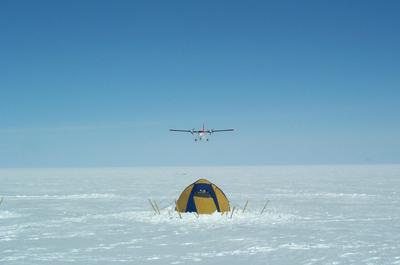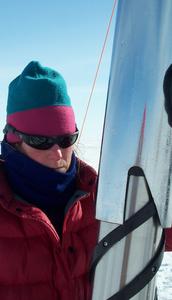2 May, 2003

This is the twin engine otter doing a fly by as they just dropped us off on the ice sheet. The two pilots are very helpful and know the seriousness of extreme climates. The plane landed as smoothly as most small aircraft. One of the nice aspects of landing on the snow instead of a runway is the plane can land or take off into the wind. It makes landing and taking off much safer. The top layer of snow is only about one inch deep. Most of the snow is drifted into a hard pack which allows for easy walking. You can see how our tents are staked with 4 foot bamboo and snow is piled around them to prevent them from disappearing in the wind. This happens to be the only twin engine otter in Greenland with skis. If this plane breaks down we would have to call Canada or Europe to have another one sent.

This is the twin engine otter doing a fly by as they just dropped us off on the ice sheet. The two pilots are very helpful and know the seriousness of extreme climates. The plane landed as smoothly as most small aircraft. One of the nice aspects of landing on the snow instead of a runway is the plane can land or take off into the wind. It makes landing and taking off much safer. The top layer of snow is only about one inch deep. Most of the snow is drifted into a hard pack which allows for easy walking. You can see how our tents are staked with 4 foot bamboo and snow is piled around them to prevent them from disappearing in the wind. This happens to be the only twin engine otter in Greenland with skis. If this plane breaks down we would have to call Canada or Europe to have another one sent.

As cores are brought up they are about 3 feet long. They then need to be processed which is one of the most important steps in field drilling. Cores need to be placed into tubes that are clearly marked with the youngest ice on top. Ryan helped dig a trench that allows core processors to work comfortably without bending down. Processing must be done with plastic gloves to minimize any contamination that could occur. We also measure for density and look for interesting marks in the core. Today we found a large melt layer that could be caused from a variety of situtations. It is interesting to bring each core of ice up and think it is a little more information about the past climate and environmental record of the Northern Hemisphere. As I look at the great vast expanse of white ice, I am amazed that this is what Wisconsin looked like 12000 years ago. Ryan Banta is a graduate student from the University Nevada in Reno. He is studying contaminates in ice cores to help determine environmental pollution. Ryan is 29 years old and is happily married to Bridget who is anxious for him to come home. The piles of snow and boxes in the background help block the wind. Temperatures this morning were -38F. It is surprising how good layers, high calorie food and continuous movement can keep you warm.
Contact the TEA in the field at
.
If you cannot connect through your browser, copy the
TEA's e-mail address in the "To:" line of
your favorite e-mail package.
|
